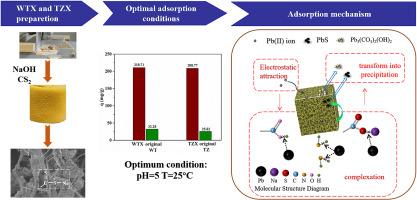三维大孔网状结构改性木粉的制备及其高效脱除Pb(II)的机理与经济评价
IF 5.8
2区 化学
Q2 CHEMISTRY, MULTIDISCIPLINARY
引用次数: 0
摘要
利用植物废弃物处理Pb(II)污染水体是一种可持续的解决方案,但对吸附能力和分离效率的担忧限制了其应用。研究了三维大孔网状结构改性木粉(WTX和TZX)的制备及其高效去除Pb(II)的应用。通过黄药改性脱脂木粉(TZ)和非脱脂木粉(WT)制备吸附剂,然后进行冻干,得到稳定的多孔结构。最佳制备条件为1.0 g原木粉与2 mL CS2在25℃强碱环境下混合3 h。WTX和TZX具有相似的三维结构和良好的固液分离性能。在45 min内,WTX和TZX对Pb(II)的去除率分别达到61%和54%,最大吸附量分别为221.73 mg/L和210.53 mg/g,显著高于未处理木粉。尽管脱脂预处理具有相似的外观和最大的Pb(II)去除能力,但并没有提高机械性能或吸附性能。Pb(II)的固定化主要通过静电吸引、络合和沉淀进行,其中-O-C (=S) -SNa、-OH、-NH2和-COOH等官能团起关键作用。经济评估强调了吸附剂的成本效益,估计每吨废水的处理成本为3.21美元。这项研究强调了废木粉生物质作为一种可持续的、低成本的重金属修复解决方案的潜力。本文章由计算机程序翻译,如有差异,请以英文原文为准。

Facile preparation of three-dimensional macroporous network structured modified wood flour for efficient Pb(II) removal from aqueous solution: mechanism and economic assessment
Utilizing plant wastes to treat Pb(II)-polluted water bodies offers a sustainable solution, but concerns over adsorption ability and separation efficiency limit its application. This study investigates the preparation and application of three-dimensional macroporous network-structured modified wood flour (WTX and TZX) for efficient Pb(II) removal. The adsorbents were synthesized through xanthate modification of defatted (TZ) and non-defatted (WT) wood flour, followed by lyophilization to achieve a stable porous structure. The optimal preparation condition involved mixing 1.0 g of original wood flour with 2 mL of CS2 in a strong base environment at 25 °C for 3 h. Both WTX and TZX exhibited similar three-dimensional structure and good solid-liquid separation performance. Pb(II) removal rates reached 61 % for WTX and 54 % for TZX within 45 min. The maximum adsorption capacities were 221.73 mg/L for WTX and 210.53 mg/g for TZX, significantly higher than untreated wood flour. Despite similar appearances and maximum Pb(II) removal abilities, the defatting pretreatment did not enhance mechanical properties or adsorption performance. Pb(II) immobilization occurred via electrostatic attraction, complexation and precipitation, with functional groups like –O–C (=S)–SNa, –OH, –NH2 and –COOH playing key roles. An economic assessment highlighted the cost-effectiveness of the adsorbents, with an estimated treatment cost of 3.21 US$/ton of wastewater. The study underscores the potential of waste wood flour biomass as a sustainable, low-cost solution for heavy metal remediation.
求助全文
通过发布文献求助,成功后即可免费获取论文全文。
去求助
来源期刊

Sustainable Chemistry and Pharmacy
Environmental Science-Pollution
CiteScore
8.20
自引率
6.70%
发文量
274
审稿时长
37 days
期刊介绍:
Sustainable Chemistry and Pharmacy publishes research that is related to chemistry, pharmacy and sustainability science in a forward oriented manner. It provides a unique forum for the publication of innovative research on the intersection and overlap of chemistry and pharmacy on the one hand and sustainability on the other hand. This includes contributions related to increasing sustainability of chemistry and pharmaceutical science and industries itself as well as their products in relation to the contribution of these to sustainability itself. As an interdisciplinary and transdisciplinary journal it addresses all sustainability related issues along the life cycle of chemical and pharmaceutical products form resource related topics until the end of life of products. This includes not only natural science based approaches and issues but also from humanities, social science and economics as far as they are dealing with sustainability related to chemistry and pharmacy. Sustainable Chemistry and Pharmacy aims at bridging between disciplines as well as developing and developed countries.
 求助内容:
求助内容: 应助结果提醒方式:
应助结果提醒方式:


